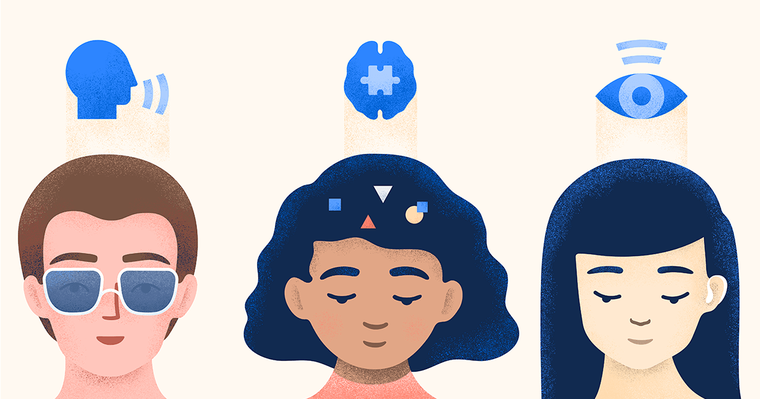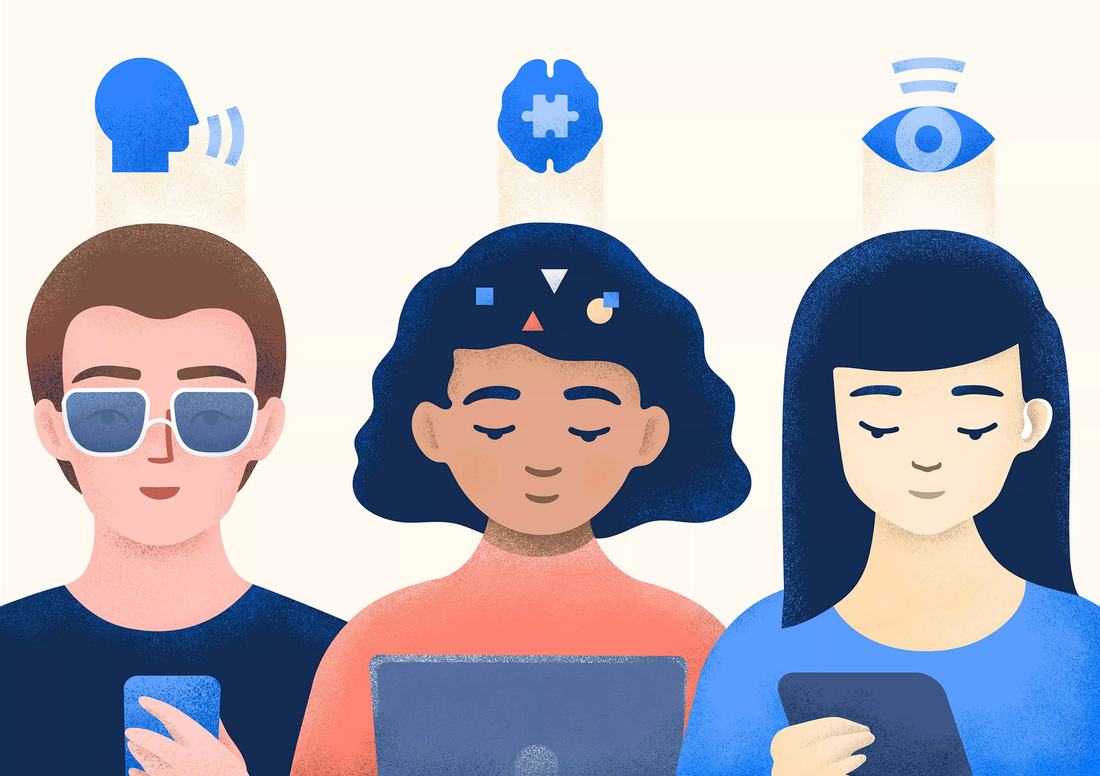
We often hear that digital health solutions are for everyone. That said, is it true? In this article, we’ll cover what digital accessibility is, why it matters in healthcare, and showcase some of the accessibility advancements we’re currently using in our own product. Let’s get started.

Accessibility isn’t just something that’s nice to have or a bonus, these days it’s an absolute must for any healthcare organization. Illustration by Magda Kościańska.
Accessibility is defined as “the quality of being able to be entered or used by everyone, including people who have a disability” by the Cambridge dictionary. This takes into account a wide variety of factors including income, sex, disability, and user location. By the numbers, if we take a look at just those individuals with disabilities, according to the World Health Organization (WHO), 1.3 billion people worldwide are affected. To put this another way, that’s roughly 17 percent of the world’s population.
It’s also important to note that this doesn’t even take into account those that suffer from temporary impairments or conditions that aren’t officially considered as disabilities. For instance, according to the WHO, there’s 2.2 billion people with some kind of vision impairment. Whilst wearing glasses doesn’t usually interfere too much with everyday life, dealing with technology can oftentimes be vision-intensive.
This is just a small fraction of the people that are affected when companies forget to make digital accessibility a priority. As tech grows, it becomes ever more imperative that the people creating the tech consider the wide variety of users that their technology will reach. This is especially true in the healthcare space and includes people that haven’t traditionally been dependent on digital solutions in the past, like the elderly or those with physical disabilities.
What this means is that healthcare technology that’s designed with accessibility in mind will oftentimes be preferred over technology that is not, providing a rather visible advantage to those working in more and more saturated markets. A lot of times, these are the people that could and would benefit most from having access to the support that the latest and greatest technological advancements can offer, especially in the healthcare space.
Considering individuals with physical disabilities is particularly important for us given that, sadly, disabilities and health problems tend to go hand in hand quite often. In fact, seniors or people with disabilities have roughly twice the risk of developing conditions such as depression, asthma, diabetes, stroke, obesity or poor oral health. Even worse, another report from the WHO notes that “(The) research shows that people with poor health are among the ones struggling the most in accessing these (digital health) tools.”
Having stated all of the above, we make sure that our healthcare solutions come with a plethora of elements specially designed for individuals with disabilities, including but not limited to:
plain language and other related elements,
screen readers (which read the text aloud),
keyboard navigation,
improvements to UX elements.
We’ll be taking a more in-depth look at these elements below, using Infermedica Triage — a module created for preliminary symptom assessment and to navigate patients to the right level of care — as an example.
We’ve translated our product into multiple languages. The fact is that, at the moment, English speakers have a significant advantage over those that are not English speakers in terms of the content that’s available and use digital health solutions more often than their non-English speaking counterparts.
According to Babbel, a large digital language services provider, the leading language used online for content is English, with over 54 percent of the world’s content being created in that language. By contrast, the second and third most used languages for online content creation reach only 6 percent. This means that the likelihood of finding what you’re looking for if you’re not an English speaker is minute by comparison. To address this, we’ve made sure that every element, including supporting content, is available in over 20 languages.
The translations are also aligned to fit with our Inclusive Design (ID) process, which looks to consider as many people as possible when we design a product. This is then even further bolstered with a strict plain language policy. The reasons why we do this are manifold, including the fact that:
a patient’s education can be a massive bar to overcome towards equality,
oftentimes migrants and those that don’t speak the local language need significantly more help linguistically when getting healthcare,
those who are economically better off tend to have better linguistic skills.
These are facts corroborated by research conducted by the WHO as well as others. As such, the only way to truly make sure that we’re as inclusive as possible is to use a standard of linguistic clarity that’ll be understood by as many people as possible. This standard aims to use simple, clear language that’s absent of vernacular, slang, and other everyday peculiarities that would leave locals at an advantage over those less familiar with the region’s nuances.
A screen reader is a device or program that reads words and images (elements) on a screen aloud using a synthesizer. From a technical point of view, there are several means of enabling this to happen, including APIs that specifically focus on accessibility and built-in voice ready devices. We ensure that our product is tested and compatible with multiple voice screen readers such as VoiceOver and NVDA.
We’ve also made the various elements in Infermedica Triage possible to navigate to with just a keyboard, i.e. focusable, including the language selector. Focusable just means, “The elements that a keyboard user can navigate to.“ By making elements focusable, those with vision- or motor-impairment can use a screen reader and keyboard to navigate all around an app or website with minimal difficulty, similarly to regular users who can scroll around using a mouse.
Lastly, we’re continuously looking at our regular UX elements and making them better, including:
Correcting the zoom options for various browsers, which allowed those with visual difficulties to easily see the browsers by increasing the zoom,
Improving the focusability of continents within the interview, making navigating the map easier for keyboard users,
Making the call to action button that lets users determine whether they’d like additional information about a question focusable, making it navigable via keyboard and readable for screen readers.
___
All elements of our solutions are regularly tested by our designers. We also invite external auditors and users with disabilities to test our solutions and plan improvements with them. Case in point, the audit we recently had has allowed us to elevate our compliance with WCAG even more.
 ED overutilization: Changing patient habits with AI-powered solutions
ED overutilization: Changing patient habits with AI-powered solutionsUnderstand why patients are misusing EDs and find solutions to mold new behaviors in your customers.
For us, taking accessibility into account in everything we do isn’t just a choice we’ve made due to the kindness of the workers that the company employs. While they most certainly are kind, there are also very real tangible rewards for taking accessibility into account.
For instance, by considering the various points of view that the individuals using digital health products may have, we can better design our products and come up with innovative ideas that more traditional competitors may not come up with. Not only is this true for us and a core part of our ID philosophy, but it’s now quickly becoming standard practice with even IT giants like Microsoft choosing to take part. And by having an ID philosophy, we can not only account for those individuals with medical disabilities, but also those whose challenges may not necessarily be recognized by the medical community.
By creating solutions that fulfill the accessibility standards, our tools can also be used by broader target audiences. Another factor that has to be considered is the law, as there are certain certifications that have specific requirements and national laws that have to be complied with in certain countries (with fines for violations in the United States ranging roughly from 75,000 to 150,000 U.S. dollars at the time of writing). By always considering accessibility in our product design, we can stay up to date with both best practices as well as any new legal regulations.
Accessibility isn’t just something that’s nice to have or a bonus, these days it’s an absolute must for any healthcare organization looking to work with the populace at large. We’d strongly like to encourage as many companies as possible to make it a priority in their own development processes. There’s very little reason to ignore accessibility when taking digital healthcare product design into consideration given the large amount of assistive technology (like screen readers) readily available and the repercussions for not considering accessibility. At the end of the day, considering accessibility is also just a fundamentally human thing to do. After all, if it were you that required some kind of assistive technology, would you want your product team or company to consider it?
Learn more about Infermedica and its AI-driven tools for healthcare.
BL/EN/2023/04/25/1
The original version of this page was published at: https://infermedica.com/blog/articles/accessibility-in-digital-health-solutions-and-why-it-matters
Infermedica's mission is to make healthcare accessible, convenient, and affordable for everyone worldwide, by automating primary care from symptom to outcome. The company develops a Medical Guidan... Read more
Artificial intelligence (AI) is the buzzword circulating in the news, on social media platforms, and at conferences worldwide across every industry. And the healthcare scene is no ...read more
As the healthcare industry becomes more competitive, organizations are under mounting pressure to meet the evolving demands of their consumers. In this article, we explore the subject ...read more
We are living in an extraordinary era for artificial intelligence (AI) in healthcare. This revolutionary technology provides so many wonderful opportunities to positively impact the ...read more
An effective digital front door needs to be much more than just the entry point into the system. Consider the front door of an office building—it is not only an entrance ...read more